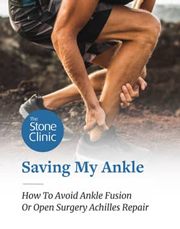Brostrom procedure rehab protocol
- Time frames mentioned in this article should be considered approximate with actual progression based upon clinical presentation. Careful observation and ongoing assessments will dictate progress.
- No passive or active inversion or eversion for 6 weeks.
- Avoid plantar flexion greater than resting position for 4 weeks.
- Carefully monitor the incisions and surrounding structures for mobility and signs of scar tissue formation. Regular soft tissue treatments (i.e. scar mobilization) to decrease fibrosis. Hold off on scar mobilizations x 4 weeks or per MD.
“No touch zone” around portals x 4 weeks
- No running, jumping, or ballistic activities for 6 months.
- Aerobic and general conditioning throughout rehabilitation process.
- M.D./nurse appointments at day 2, day 14, 1 month, 2 months, 4 months, 6 months, and 1 year post-operatively.
Weeks 0 - 3
- Posterior splint immobilizer for 3 weeks.
- Non weight bearing for 3 weeks--no push off or toe-touch walking.
- Pain and edema control / modalities as needed (i.e.cryotherapy, electrical stimulation, soft tissue treatments).
Manual
- Effleurage, gentle soft tissue mobilization to ankle avoiding incisions. Keep 2 inch “no touch zone” around portals x 4 weeks.
Exercises
- Toe curls, toe extension, toe spreads, hip and knee strengthening exercises.
- Well-leg cycling, well body weight training,
Goals
- Minimal edema.
- Closed incision sites.
- Increased core/gluteal strength.
Weeks 3 - 6
- Progress from posterior splint to pneumatic walking boot. Be sure to wear a heel lift in opposite shoe to offset the leg length discrepancy caused by the boot.
- Progress to full weight bearing in walking boot. Walking boot weight bearing for 3-6 weeks post-op.
- Aircast splint for sleeping at night (make sure sheets/covers are not pushing foot down into plantarflexion).
Manual
- Continue with effleurage and soft tissue mobilizations. Regular mobilization of intermetatarsal and midtarsal joints. Caution with talocrural and subtalar mobilization.
Exercises
- Isometrics in multiple planes and progress to active exercises in protected ranges.
- Proprioception exercises, intrinsic muscle strengthening, manual resisted exercises.
- Cycling with boot, aerobic machines in splint as tolerated, and pool workouts in splint once incisions closed. No fins in pool until 12 weeks.
Goals
- Initiate gentle dorsiflexion- slow progression to full range of motion.
- No edema.
- Gait full weight bearing, good mechanics.
Weeks 6 - 12
- Progress from boot to aircast at 8 weeks post operatively.
Manual
- Continue with soft tissue mobilization, mobilization of ankle/foot as needed for range of motion.
Exercises
- Gradually increase intensity of exercises focusing on closed-chain and balance / proprioception.
- At 8 weeks post op- gradual and slow progression of passive and active range of motion exercises into inversion and eversion cautiously.
- Initiate stationary cycling, no clip ins, light to no resistance, and slow cadence.
Goals
- Full passive/active range of motion by end of 12 weeks.
- Normal gait mechanics.
- Able to do single leg heel raise.
- Able to do single leg balance >30 sec.
Months 3 - 6
- Progress from aircast to ASO lace-up ankle brace.
- Progress back into athletics based upon functional status.
- Wear a lace-up ankle support for athletics.
- Pool work outs, weaning out of splint.
Goals
- Able to perform 3 and 6 month Sport Tests.
- Begin plyometric training and initiate return to run program with lace up brace.
NOTE:-Time frames mentioned in this article should be considered approximate with actual progression basedupon clinical presentation. Careful observation and ongoing assessments will dictate progress.
